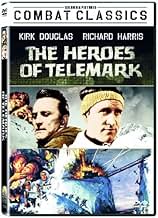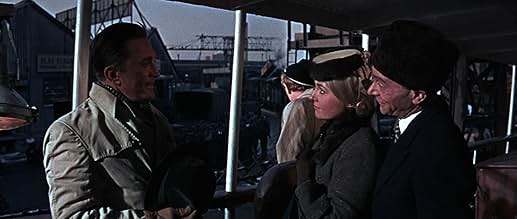Durante la Seconda Guerra Mondiale, la resistenza norvegese cerca di bloccare i tentativi tedeschi di produrre un componente per la bomba atomica.Durante la Seconda Guerra Mondiale, la resistenza norvegese cerca di bloccare i tentativi tedeschi di produrre un componente per la bomba atomica.Durante la Seconda Guerra Mondiale, la resistenza norvegese cerca di bloccare i tentativi tedeschi di produrre un componente per la bomba atomica.
Trama
Lo sapevi?
- QuizIn early 1940, the Allies approved a naval campaign designed to seize the northern part of Norway, a neutral country, including the key port of Narvik, and possibly also to seize the iron mines at Gällivare in northern Sweden, from which Germany obtained much of its iron ore. The British planned to invade Norway in March 1940 to use the ports as bases for the Royal Navy in order to encircle Germany, but the operation (codenamed Plan R 4) was postponed. The British and French had previously planned to invade Sweden, in order to assist Finland during the Winter War against the Soviet Union. Adolf Hitler found out about Plan R 4, and militarily intervened as the British began Operation Wilfred by laying mines in neutral Norwegian waters.
- BlooperEarly in the movie Dr Pedersen enters a boat in Oslo harbor to go to Trondheim. Nobody would take a boat from Oslo to Trondheim (a long trip lasting several days) as there is a direct train lasting 8-10 hours. In any case there was never a regular boat service from Oslo to Trondheim. Later Pedersen says he is going to Kristiansund, a town south of Trondheim.
- Citazioni
Terboven: Winston Churchill is puffing an extra big cigar today. And we laugh at him. Why? Because all these containers, which the British did so much to destroy, have already been pre-fabricated in Berlin. They are already on their way here and will be installed by tomorrow.
Nilssen: That is... I must say that is fantastic efficiency!
Terboven: Don't you ever make the mistake of under-rating the Germans. By Easter we will have not merely 10,000 pounds of heavy water, but 12,000 pounds of heavy water.
- Curiosità sui creditiOpening credits prologue: GERMAN-OCCUPIED NORWAY 1942
- ConnessioniEdited into Krigens beste historie - Kampen om tungtvannet (2015)
1942, Nazi occupied Norway, and the Germans are making great strides with their plans for atomic weaponry. It's down to a band of resistance fighters and a scientist to blow up the German heavy water factory located up in the Telemark mountains.
Perhaps it's stating the obvious considering Mann and Krasker's reputations as quality visualists, but The Heroes of Telemark is a splendid looking war movie. It's solidly performed by the cast, the story, which is based on a real and crucial incident in the war, is gripping, while some of the tech flourishes shown by Mann for the more pacy scenes are impressive.
Problems only really arise when the film resorts to standard character interactions, shifting focus away from the film's strength, that of the mission, the planning and execution of such. The script doesn't really give the characters much to work with, so in truth it's hard to really care about them in context to their own personal trials and tribulations.
However, such is the visual treats and excellent action choreography on show, it still rounds out as a wholesome meaty war epic well worth investing time with. 7/10
- hitchcockthelegend
- 21 mar 2014
- Permalink
I più visti
Dettagli
- Data di uscita
- Paese di origine
- Siti ufficiali
- Lingue
- Celebre anche come
- The Heroes of Telemark
- Luoghi delle riprese
- Azienda produttrice
- Vedi altri crediti dell’azienda su IMDbPro
Botteghino
- Budget
- 5.600.000 USD (previsto)
- Tempo di esecuzione2 ore 11 minuti
- Proporzioni
- 2.35 : 1
Contribuisci a questa pagina



































